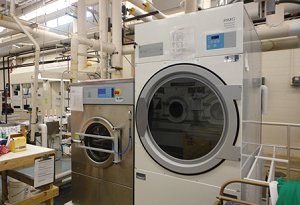
Dropping off the dry cleaning – it seems just like another item on the “to-do” list, but here on campus, it has recently become another opportunity to make a decision to live more sustainably.
St. Michael’s Laundry recently utilized the Green Loan Fund to replace a 1990’s model dry cleaning machine with a state-of-the-art wet cleaning machine. The machine uses only soap and water to effectively clean dry clean-only clothing, providing an environmentally friendly alternative to dry cleaning.
“The name ‘dry cleaning’ is pretty misleading: it’s actually not dry at all,” explained Erin Hafner, Programs Manager in the Office of Sustainability, who worked with St. Michael’s to collect the data for the Green Loan Fund proposal. “It’s called dry cleaning because it does not use water. Instead, the dry cleaning process involves soaking the clothes in chemical solvents, most commonly perchloroethylene (PERC).”
PERC negatively affects both the respiratory and nervous systems and is listed as a potential carcinogen. Long-term exposure can lead to kidney and liver damage, memory loss, and confusion. PERC can easily penetrate the soil and leach into groundwater as well. Disposal requires contracting a hazardous waste hauler and paying for disposal at a hazardous waste facility.
Previously, St. Michael’s spent thousands of dollars each year to purchase PERC and to dispose of it. In addition to the avoided costs associated with PERC, the new and more efficient machine will save energy and have lower maintenance costs. With the combined savings, St. Michael’s will be able to repay the Green Loan Fund over the next four years.
New technology has recently made the wet cleaning process more feasible for delicate ‘dry clean only’ clothes. “Clothes are placed in the computer-controlled washer, a unique formula of soap and water (depending on the type of clothing) is added, and the washer rocks back and forth instead of rotating a full 360° to minimize wear on the clothes,” explained Robin Kramer, Associate Director at St. Michael’s Laundry. “Once the washing cycle is complete, the clothes are placed in a humidity-controlled dryer that leaves enough moisture in the clothing to allow it to be pressed to its correct shape. No chemicals are used during the process, with the result that finished clothes have a fresh scent and no chemical residue.”
To date, three St. Michael’s employees have each completed over 50 hours of training for the wet cleaning machine, including a 5-day certification course at the Drycleaning and Laundry Institute in Maryland. “The employees are excited to be working with the new equipment,” said Kramer, “and they appreciate that St. Michael’s has taken an interest in reducing its environmental footprint while giving customers the opportunity to do so as well.” Between February and July of this year, St. Michael’s successfully wet cleaned over 3,500 items of clothing, and associates are currently offering customers the opportunity to try this eco-friendly option.